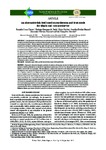Por favor, use este identificador para citar o enlazar este ítem:
http://www.alice.cnptia.embrapa.br/alice/handle/doc/1054024Registro completo de metadatos
| Campo DC | Valor | Lengua/Idioma |
|---|---|---|
| dc.contributor.author | CHAVES, R. C. | pt_BR |
| dc.contributor.author | PAULA, R. Q. de | pt_BR |
| dc.contributor.author | GÜCKER, B. | pt_BR |
| dc.contributor.author | MARRIEL, I. E. | pt_BR |
| dc.contributor.author | TEIXEIRA, A. O. | pt_BR |
| dc.contributor.author | BOËCHAT, I. G. | pt_BR |
| dc.date.accessioned | 2016-10-03T11:11:11Z | pt_BR |
| dc.date.available | 2016-10-03T11:11:11Z | pt_BR |
| dc.date.created | 2016-10-03 | pt_BR |
| dc.date.issued | 2015 | pt_BR |
| dc.identifier.citation | Revista Brasileira de Biociências, Porto Alegre, v. 13, n. 1, p. 15-24, jan./mar. 2015. | pt_BR |
| dc.identifier.uri | http://www.alice.cnptia.embrapa.br/alice/handle/doc/1054024 | pt_BR |
| dc.description | (An alternative fish feed based on earthworm and fruit meals for tilapia and carp postlarvae). The search for alternative protein and lipid sources in the nutrition of aquatic organisms in captivity is extremely important for sustainability and ecosystem preservation. We investigated the potential of a new alternative fish feed based on fruits and earthworm and soybean meals for the nutrition of postlarvae of two high-value fish species cultivated worldwide, Nile tilapia (Oreochromis niloticus L.) and common carp (Cyprinus carpio L.). ostlarvae fed the alternative diet exhibited growth and weight gain similar to those fed a commercial fishmeal-based feed. Although concentrations of minerals and total protein were higher in the commercial than in the alternative feed, lipid concentration was higher in the latter. Tissue concentrations of minerals, protein and lipid, however, did not differ between postlarvae fed the commercial and the alternative feeds. This result suggests a high assimilation efficiency of the alternative feed compared to the commercial feed. The alternative feed tested in our study proved to be efficient in promoting growth and weight gain of carp and tilapia postlarvae. Due to its simple formulation, based on ingredients commonly found in tropical countries, the proposed alternative fish feed offers an economically viable and environmentally sound alternative for fish farmers in these countries. | pt_BR |
| dc.language.iso | por | pt_BR |
| dc.rights | openAccess | pt_BR |
| dc.title | An alternative fish feed based on earthworm and fruit meals. | pt_BR |
| dc.type | Artigo de periódico | pt_BR |
| dc.date.updated | 2017-05-18T11:11:11Z | pt_BR |
| dc.subject.thesagro | Alevino | pt_BR |
| dc.subject.thesagro | Nutrição | pt_BR |
| dc.subject.thesagro | Piscicultura | pt_BR |
| dc.subject.thesagro | Aquicultura | pt_BR |
| dc.subject.nalthesaurus | Aquaculture | pt_BR |
| dc.subject.nalthesaurus | Postlarvae | pt_BR |
| dc.subject.nalthesaurus | Fish production | pt_BR |
| riaa.ainfo.id | 1054024 | pt_BR |
| riaa.ainfo.lastupdate | 2017-05-18 | pt_BR |
| dc.contributor.institution | Ronaldo César Chaves, Universidade Federal de São João del-Rei; Rodrigo Queiroga de Paula, Universidade Federal de São João del-Rei; Björn Gücker, Universidade Federal de São João del-Rei; IVANILDO EVODIO MARRIEL, CNPMS; Alexandre Oliveira Teixeira, Universidade Federal de São João del-Rei; Iola Gonçalves Boëchat, Universidade Federal de São João del-Rei. | pt_BR |
| Aparece en las colecciones: | Artigo em periódico indexado (CNPMS)  | |
Ficheros en este ítem:
| Fichero | Descripción | Tamaño | Formato | |
|---|---|---|---|---|
| Analternative.pdf | 2,17 MB | Adobe PDF |  Visualizar/Abrir |









